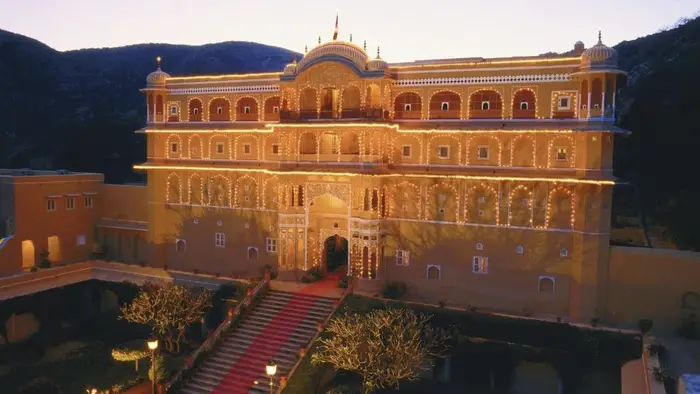Samode Palace, Samode Haveli, and Samode Bagh (Garden) are heritage buildings located in the Pink City of India. They were built by noble families who had titles like ‘Maha Rawal’ or ‘Maha Saheb’. These buildings have a long history of hundreds of years and show a mix of Mughal and Rajasthani art and architecture.
Today, they are part of a group of hotels called “Samode,” owned by the same families who built them. The Samode Palace is located 40 kilometers north of Jaipur, the Samode Haveli is near Jaipur (about 6 kilometers away from the city railway station), and the Samode Bagh or Garden is about 4 kilometers away from the palace and is also a luxury hotel. Here are things you didn’t know about one of the most famous palaces in Jaipur!
History of Samode Palace in Jaipur
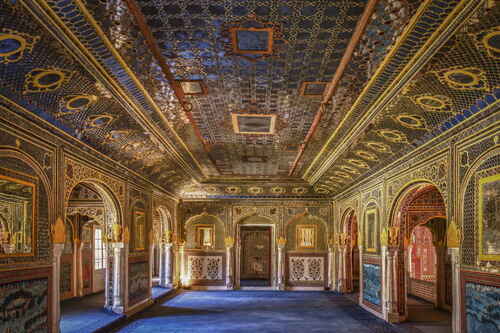
Samode is a big town in Rajasthan, India. It was ruled by the landlords known as ‘zamindars’ in Hindi, who were part of the Amber state’s Thakur families. The town gained fame because of its connection to Maharaja Rajveer Singh, the 17th prince of the Kachwaha Rajputs. Gopal Singhji, one of his 12 sons, became a noble feudatory of the Amber and Jaipur principality and inherited Samode, which was already a prosperous town. Later, the Zamindari of Samode was passed down to Behari Das, a Rajput warrior in the service of the Nathawat clan, who received it during the time of British rule. In 1757, the British restored the ownership of Samode to the Nathawat clan, granting them the hereditary titles of ‘Rawal Saheb’ or ‘Maha Rawal’ due to their bravery and loyalty to the royal family. This lineage continues to this day.
Originally constructed as a Rajput fort in the 16th century, Samode Palace underwent a transformation in the early 19th century under Rawal Berisal, a nobleman and the chief minister of Rajasthan. It was converted into a stunning palace with a blend of Rajput and Muslim architectural styles. Rawal Berisal also played a role in the signing of the 1818 treaty between the Maharaja of Jaipur and the British East India Company, which established Jaipur as a protected state. Rawal Sheo Singh, a descendant of Rawal Berisal and the prime minister of Jaipur during the mid-19th century, further expanded the palace by adding the Durbar Hall, known for its extravagant hand-painted decorations, and the Sheesh Mahal, also known as the hall of mirrors. In 1987, the palace was transformed into the heritage hotel known as “Samode Palace Hotel.”
Samode Haveli, another structure in Samode, was built by Rawal Sheo Singh over 150 years ago. It was designed as a retreat for the royal family.
Samode Bagh, also referred to as Samode Garden, was created over 150 years ago by one of the sons of Maharaja Prithiraj Singhji of Jaipur. It was inspired by the Mughal gardens found in other parts of the Mughal kingdom, providing a serene space for relaxation and enjoyment. The royal family of Samode also established a similar garden located 4 kilometers away from Samode Palace.
Exploring the Rich Legacy: The Heritage Structures of Samode
Samode a captivating town in Rajasthan, India, unveils its magnificent heritage structures, encapsulating centuries of history and culture. From the majestic Samode Palace to the elegant Samode Haveli and the tranquil Samode Bagh, these architectural marvels bear witness to the seamless blend of Mughal and Rajasthani artistry.
Join us on an immersive journey as we unravel the tales and allure of Samode’s Heritage Structures.
Samode Palace in Jaipur
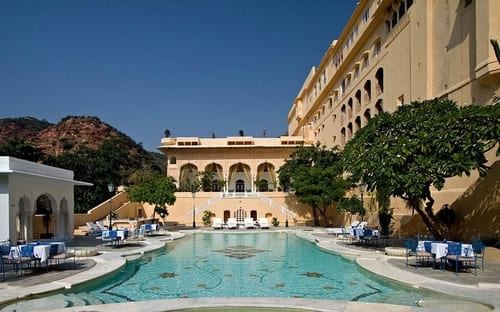
Located on the outskirts of Shekhawat, near the charming Samode village, stands a magnificent palace steeped in history. This architectural gem was constructed by the noble courtiers of the royal family, showcasing the regal splendor of Rajasthan. Crafted from sandstone and nestled at the foothills of the Aravalli range, the palace exudes a fortress-like charm.
Step inside, and you’ll be greeted by the grandeur of Rajasthan’s ancient architectural style. Marble floors, intricately adorned pillars, and mosaic walls adorned with meticulously crafted inlaid stones create a captivating atmosphere. Luxurious carpets grace the floors, while old wall paintings depict hunting scenes and delicate floral motifs. As you approach the palace’s entrance gate, a sight to behold awaits you—a large-sized treasure chest crafted from dark wood, adorned with marble accents and gleaming glass.
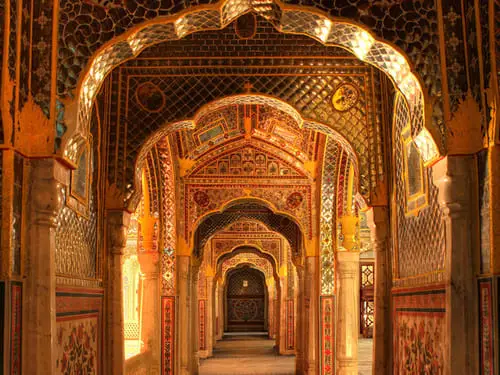
Venture further, and you’ll discover the Sheesh Mahal, the Hall of Mirrors, located on the southern side of the palace. Within the Durbar Hall and Sultan Mahal, frescoes that have withstood the test of time tell stories that are over 250 years old. The palace is ingeniously designed with three levels, each featuring a charming courtyard, gradually ascending in height. A panoramic view of the valley unfolds from the ruins of an ancient fort that perches above the palace. Although nature has reclaimed the fort with abundant vegetation, stone-paved paths lead the way, inviting you to explore its heights. To reach the fort, a well-laid stone path of 300 steps guides your ascent. Completing the circular walk from the palace are two additional forts, while a small temple just 3 kilometers away.
The Samode village, located near the palace, is renowned for its exquisite textiles, created through the traditional art of block printing. The village also boasts a vibrant handicraft scene, with skilled artisans specializing in bangle making. Don’t miss the opportunity to visit the small artists’ colony, where intricate miniature paintings come to life, showcasing the region’s rich artistic heritage.
Samode Haveli in Jaipur

Facing towards the north, the haveli stands as a symbol to timeless beauty. As you step inside, there is an elegant painted dining room with a well-designed air passage. What makes this haveli truly extraordinary is the perfect blend of historic charm and contemporary elements, creating a unique ambiance that captivates all who enter.
A remarkable feature awaits you at the entrance of the haveli—a specially constructed elephant ramp. This magnificent addition was created in 1940 to commemorate a joyous occasion—the wedding ceremony of a member of the Royal family. As you ascend this grand ramp, you can’t help but be immersed in the rich history and cultural significance it represents.
Samode Bagh in Jaipur

Samode Bagh, also known as the garden, is a beautiful Mughal-style garden that was built in the 16th century. It is surrounded by a high wall that is 15 feet tall. The garden covers a large area of 20 acres and has 44 tents for visitors to stay in. These tents are colored like the sandbanks and have air conditioning to keep guests comfortable. Inside the tents, you will find a mix of traditional Rajasthani and Mughal decorations with a touch of Victorian style. They are equipped with modern facilities like carpets, standing lamps, well-designed beds, chairs, and more.
One of the highlights of the garden is a long water channel that stretches for 200 feet. This channel is lined with beautiful fountains that get their water from natural springs and wells. The walls of the tents are adorned with elegant paintings in the Mughal art style, adding to the charm of the surroundings. Additionally, within the garden, there is a pavilion that is 150 years old, offering a glimpse into the history of this enchanting place.
Essential Information for Visitors about the Samode Palace in Jaipur
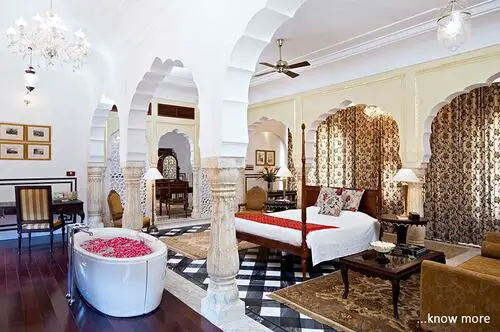
The palace, haveli, and garden are located at different distances from Jaipur. The palace is about 42 kilometers (26 miles) away, the haveli is approximately 6 kilometers (3.7 miles) away, and the garden is about 45 kilometers (28 miles) away. Jaipur itself is well connected to other major cities in India through rail, road, and air transportation. If you are traveling by road, Jaipur is 260 kilometers (160 miles) from Delhi, and you can reach it via the National Highway NH-8.
To visit the palace, there is an entry fee of Rs 1,000 per person. This fee includes a tour of the palace and can also be used as credit towards food and drinks at the courtyard restaurant. During the tour, you will get to explore various areas such as the ladies waiting rooms, the shish mahal (room of mirrors), the Durbar hall, and the pool area (for viewing purposes only, no swimming allowed).
FAQs: Samode Palace in Jaipur
Below are the frequently asked questions about Samode Palace in Jaipur:
Samode Palace in Jaipur, Rajasthan has 43 well-equipped rooms which include 3 Royal Suites 15 Deluxe suites and 25 Deluxe Rooms.
These incredible properties have been carefully restored to their original magnificence and are now managed by the current owners, Rawal Raghavendra Singh and Yadavendra Singh. They are direct descendants of the royal family of Samode.
Samode Palace was first constructed in the 16th century as a fort by the Rajput people. However, during the early 19th century, a nobleman named Rawal Berisal transformed it into a stunning palace. The palace was designed with a combination of Rajput and Muslim architectural styles, resulting in its exquisite and captivating appearance.
The distance from Jaipur Airport (JAI) to Samode Palace is 42 kilometers.
With a rich history spanning 475 years, Samode Palace is a true architectural marvel nestled in the rugged hills of Rajasthan. Situated just an hour’s drive away from the state capital, Jaipur, this magnificent structure has undergone various transformations throughout its storied existence.
Located just 4 KMs away from the splendid Samode Palace, Samode Bagh is a picturesque garden paradise.
